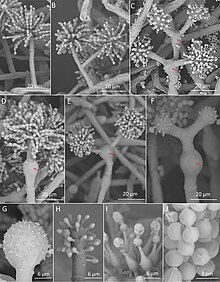Escovopsis
| Escovopsis | |
|---|---|

| |
Conidia
| |
| Scientific classification | |
| Kingdom: | Fungi |
| Division: | |
| Class: | |
| Order: | |
| Family: | |
| Genus: | Escovopsis J.J.Muchovej & Della Lucia (1990)
|
| Type species | |
| Escovopsis weberi J.J.Muchovej & Della Lucia (1990)
| |
| Species | |
|
E. aspergilloides | |
| Synonyms[3] | |
Escovopsis is a
In an early 2015 published study, scientists collected five species of Escovopsis from both genera of fungus-growing ants,
A separate study published in January 2015 also looked at the lower attine ant, Mycetophylax morschi, in Brazil and found four strains for the Escovopsis. The scientists that conducted this research also noticed distinguishable features of the Escovopsis such as the type and physicality of the conidiophores and conidiogenous cells and the DNA sequences. They named the species Escovopsis kreiselii.[6]
Parasitism
This genus describes a parasitic fungus capable of horizontally transmitting between colonies, which can affect any of the 47 species of ants commonly known as the leafcutter ants, which are widespread in parts of the Americas. The fungus transmits itself between colonies by utilizing infected external material.[7] Only two species of the pathogenic Escovopsis have been formally made known, although the other rising species and Escovopsis in general is known to act destructively toward to the symbiotic relationship between the ant colonies and their fungus gardens. It was only established as a symbiont of this ant-fungus mutualism proceeding studies that consistently isolated the fungus.[8] However, the leafcutter ants have a defense mechanism against the parasitic fungus, an antifungal actinobacteria from the genus Pseudonocardia.
A study conducted at the
Leafcutter ants communicate through exchanges of chemicals and secrete chemicals made from actinomycete bacteria in order to protect their colonies. The Atta colonies have a hierarchal system of workers and use chemical secretions through metapleural glands, which are capable of producing much phenylacetic acid, an antimicrobial agent. A study demonstrated how the smallest worker ants were able to lower growth rates of Escovopsis spores that were placed into the ants’ fungus garden with this phenylacetic acid. Bioassays showed that Escovopsis from leafcutter ants is not as affected by the acid than that from more basic fungus-growing ants, meaning that there is a need to control the growth of the parasitic Escovopsis fungus because of its virulence as a potential pathogen.[10]
References
- ^ PMID 30814906.
- PMID 4664531.
- ^ "Synonymy: Escovopsis J.J. Muchovej & Della Lucia". Species Fungorum. CAB International. Archived from the original on 17 January 2022. Retrieved 2 June 2015.
- ^ Muchovej JJ, Della Lucia TMC. (1990). "Escovopsis, a new genus from leaf cutting ant nests to replace Phialocladus nomen invalidum". Mycotaxon. 37: 191–195. Archived from the original on 23 September 2015. Retrieved 2 June 2015.
- ^ Masiulionis, V. E., et al. "Escovopsis trichodermoides Sp Nov., Isolated from a Nest of the Lower Attine Ant Mycocepurus Goeldii." Antonie van Leeuwenhoek 107.3 (2015): 731–40.
- ^ Meirelles, L. A., et al. "New Light on the Systematics of Fungi Associated with Attine Ant Gardens and the Description of Escovopsis Kreiselii Sp Nov."PLOS ONE 10.1 (2015): 14.
- ^ http://www.zompopas.com/index.php%3Foption%3Dcom_content%26view%3Darticle%26id%3D9%26Itemid%3D7%26lang%3Den. Retrieved 1 June 2015.
{{cite web}}: Missing or empty|title=(help)[dead link] - ^ Caldera, E. J., et al. "Insect Symbioses: A Case Study of Past, Present, and Future Fungus-Growing Ant Research." Environmental Entomology 38.1 (2009): 78–92.
- ^ Wallace, D. E. E., J. G. V. Asensio, and A. A. P. Tomas. "Correlation between Virulence and Genetic Structure of Escovopsis Strains from Leaf-Cutting Ant Colonies in Costa Rica." Microbiology-Sgm 160 (2014): 1727–36.
- ^ Fernandez-Marin, Hermogenes, et al. "Functional Role of Phenylacetic Acid from Metapleural Gland Secretions in Controlling Fungal Pathogens in Evolutionarily Derived Leaf-Cutting Ants." Proceedings: Biological Sciences 282.1807 (2015). Print.
